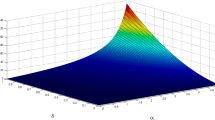Abstract
In this paper, under the constraint that the average distance and the average degree 〈k〉 remain approximately constant, we studied a random scale-free network model. We found that, if the network maintains the form of its degree distribution and the maximal degree k c is N-dependent cutoff function k c (N) < N, the degree distribution would be approximately power-law with an exponent between 2 and 3. The distribution exponent has little relationship with the average degree, denoted by 〈k〉. The diameter constraint can be interpreted as an environmental selection pressure, which could explain the scale-free nature of networks. The numerical results indicate that, under the diameter constraint, the preferential attachment can produce the cutoff function k c (N) < N and power-law degree distribution.
Similar content being viewed by others
References
Albert, R. & Barabasi, A. L. (2002). Statistical mechanics of complex networks. Reviews of Modern Physics, 74:47–97
Faloutsos, M., Faloutsos, P. & Faloutsos, C. (1999). On power-law relationships of the internet topology. ACM SIGCOMM Computer Communication Review, 29(4): 251–262
Jeong, H., Albert, R. & Barabasi, A.L. (1999). Diameter of the world-wide web. Nature, 401: 130–131
Mendes, J.F.F., Dorogovtsev, S. N. & Ioffe, A.F. (2003). Evolution of Networks: From Biological Nets to the Internet and the WWW, Oxford University Press, Oxford
Newman, M.E.J. (2003). The structure and function of complex networks. SIAM Review, 45:167–256
Pastor-Satorras, R. & Vespignani, A. (2004). Evolution and Structure of the Internet: A Statistical Physics Approach, Cambridge University Press, Cambridge
Wang, X.F. (2002). Complex networks: Topology, dynamics and synchronization. International Journal of Bifurcation and Chaos, 12: 885–916
Author information
Authors and Affiliations
Corresponding author
Additional information
This work was supported by NSFC under Grant Nos. 70431001 and 70271046.
Jianguo Liu is doctoral student of Institute of System Engineering, Dalian University of Technology. His current research interests are complex networks and knowledge management. He has published papers in journals such as Physica A, Modern Physics Letters B, Chinese Physics Letters, Journal of Applied and Mathematic Computing etc.
Zhongtuo Wang is Professor of Institute of System Engineering, Dalian University of Technology, Member of Chinese Academy of Engineering. He had developed some business IT application systems. His publications include 10 books, and over 140 papers and reports. His current research interests are knowledge management, complex networks and super-networks.
Yanzhong Dang is Professor of Institute of System Engineering, Dalian University of Technology. His current research interests are knowledge management, knowledge mining etc.
Rights and permissions
About this article
Cite this article
Liu, J., Wang, Z. & Dang, Y. Random evolving networks under the diameter and average connectivity constraint. J. Syst. Sci. Syst. Eng. 16, 107–112 (2007). https://doi.org/10.1007/s11518-007-5031-0
Issue Date:
DOI: https://doi.org/10.1007/s11518-007-5031-0




